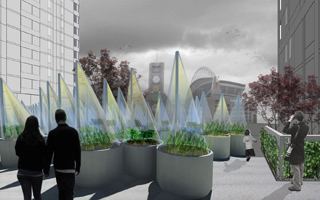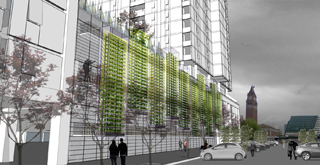|
Subscribe / Renew |
|
|
Contact Us |
|
| ► Subscribe to our Free Weekly Newsletter | |
| home | Welcome, sign in or click here to subscribe. | login |
Real Estate
| |
 Marc Stiles Real Estate Editor |
July 28, 2011
Real Estate Buzz: Urban farming grows on Kevin Daniels
Real Estate Editor
Farming and commercial real estate typically don't have much to do with each other. More often than not, they're at odds. And communism and capitalism? They're definitely different.
But Seattle developer Kevin Daniels is melding these incongruous elements as part of a 1.5 million-square-foot mixed-use complex called Stadium Place that he is developing with R.D. Merrill Co. in the north lot of CenturyLink Field.
His idea for putting an urban farm at Stadium Place was inspired by the urban farms he saw several years ago on a trip to Havana, but he won't be giving away the produce he hopes to grow on a roof and the wall of a parking garage.
The site today is nearly 4 acres of asphalt, but if his plan comes to fruition gardens could produce everything from arugula to zucchini for Stadium Place restaurants and residents, as well as farmers' markets.
But first Daniels needs to find a farmer. He shouldn't have any trouble if the new Sustainable Agriculture Education, or SAgE program, at Seattle Central Community College is any indication. More than 320 students have enrolled in the classes since SAgE started two years ago.
“All of our classes have been full, pretty much,” said Jason Niebler, program director. The popularity is driven by a desire among young people to “reconnect with their physical environment, with nature, in a way that's really tangible.”
Interest in farming is one thing. Actual farming is something else. It can be grueling work. (Ever manually weeded 40 acres of soybeans in 95-degree weather? The Buzz has.) This is why Daniels says he wants to be recruited by the farmer, “not the other way around.”
The Stadium Place plots won't be your regular farms. One will be on top of a podium that supports three high rise apartment towers. It will be part of the outdoor space for residents. The other plot will be attached to a parking garage wall at the base of an office building. Daniels wanted low-tech, off-the-shelf solutions for both of these projects, and turned to Seattle architect Susan Jones of atelierjones.
For the farm on the 15,000-square-foot podium, Jones devised a system of 150 planters, or miniature greenhouses, made of concrete culverts 5 feet in diameter and 4 feet tall. A small cistern at the base will be topped by soil. The culverts will be exposed during in the warmer months, and can be converted into greenhouses with the insertion of a steel pole in the planter. A translucent sheet of plastic would hang from the pole and wrap around the edges of the culvert, creating a half teepee-like cover. A fluorescent bulb attached to the pole will provide heat and light.
Daniels was smitten with the concept but wanted to take it a step further: add colored LED lights that glow in seasonally appropriate hues — Seahawk blue or Sounder green — for a striking addition to the view of Stadium Place from the stadium.
Hanging a farm from a parking garage wall is more complicated, and has never been done as far as Jones knows. She proposes a system of hydroponic trays on a conveyor that would allow the farmer to rotate the trays, exposing half the plants to direct light while the other half is somewhat shaded behind them.
The system would be protected by a light-weight membrane “pillow-panel” construction that does not require a secondary structure. The 2008 Beijing Olympic swimming center, the Water Cube, used this technology.
“Kevin wanted an innovative project,” said Jones. “He's got one. He wanted something that would surprise people. He's getting that.”
$570 a foot for 1918 Eighth?
There's some buzz about how much Schnitzer West could get for its 1918 Eighth Avenue tower.
The 36-story building was slow to fill up after it was completed two years ago. That changed this spring when Amazon.com leased about 460,000 square feet, bringing the building to 94 percent occupied, Schnitzer officials said. That makes it exactly the kind of asset that investors crave.
Talk among brokers is that the building will go for more than $380.7 million, or $570 a foot. That would set a post-recession record that's now held by the sale of another Schnitzer West development: the office portion of The Bravern in Bellevue that went for $548 a foot last year.
It's believed that the region's per square foot record is $635. That was reached with the sale of Market Place I & II in Seattle in 2007.
Schuster writes book, wins award
Congratulations to Mark Schuster, the Seattle developer and writer whose book “Lofty Pursuits: Repairing the World One Building at a Time” won the 2011 Eric Hoffer Book Award.
Hoffer was a former migratory worker and longshoreman who remained true to his working-class roots after becoming an acclaimed writer and philosopher.
“Lofty Pursuits” tells the sometimes harrowing tale of developing Mosler Lofts, and how Schuster went from scrubbing toilets to building a multi-million dollar real estate investment business.
In its review, the Hoffer award committee wrote, that “Lofty Pursuits” is “truly an inspiring book, teaching us of lessons learned and reminding us that hard work, perseverance, and selecting the most honorable course of action matters.”
Got a Buzz tip? Send it to marc@djc.com or call (206) 219-6517.
Got a tip? Contact DJC real estate editor Brian Miller at brian.miller@djc.com or call him at (206) 219-6517.
Previous columns:
- Real Estate Buzz: Tenants, investors looking at Civic Square, 07-21-2011
- Real Estate Buzz: Ballard eyesore gets a whole new look, 07-14-2011
- Real Estate Buzz: Judd Kirk stepping down at Port Blakely, 06-30-2011
- Real Estate Buzz: Few distressed sales here, except this one, 06-23-2011
- Real Estate Buzz: Facebook looking for more office space, 06-16-2011
- Real Estate Buzz: Is big Des Moines project about to take off?, 06-09-2011
- Real Estate Buzz: Tire kickers gather at the Goodyear site, 06-02-2011
- Real Estate Buzz: Google, Getty and the search for space, 05-26-2011




